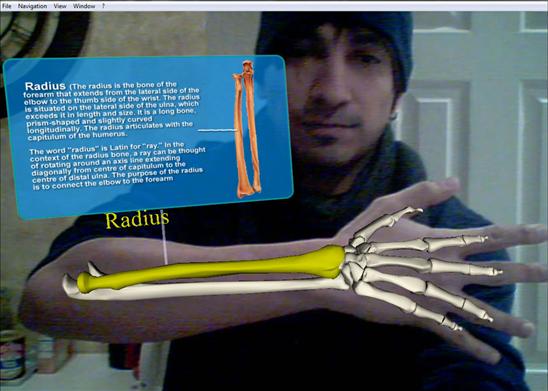
(Image from Metaverse One on TweetPhoto).
I’m not sure if this is just a mockup or an actual working prototype (the latter would surprise me), but this “interactive educational augmented reality medical app” is a great concept. I found it via Bruce Sterling, and it reminds me of some of the stuff from his State of the Future 2010:
If patients end up doing their own diagnoses by aggregating patient data, using Web 2.0 style collective intelligence, and especially if they then start suing doctors who make demonstrable, dumb mistakes, the practice of medicine will be wrecked. Not improved, wrecked. It’ll be hugely damaged, in the same way that the music business was damaged by Napster, and newspapers were wrecked by Craigslist, or the Democratic Party was outmaneuvered and tamed by some Chicago guy who had social media and a digital fundraising machine.
Doctors do make dumb mistakes all the time. That’s the nature of a knowledge guild that restricts vital knowledge to a professional clique.
We didn’t want amateur brain surgeons because they are dangerous quacks without medical ethics. But there’s no physical reason why one couldn’t have amateur brain surgeons with instructables off Wikipedia,
and no reason why theses jaspers couldn’t do a sort-of-okay job, too. Not perfect, but cheap and fast and distributed and upgradeable, like Wikipedia compared to Encyclopedia Britannica.That’s network culture. If medicine gets the big wikipedia treatment, you don’t get a computer-literate doctor, you get a doctor-literate web activist.
Strange and scary to think about – the current health care debate could be obsolete before we know it, with a whole new host of controversies to consider.
See also: Biopunk: the biotechnology black market
January 11, 2010 at 7:54 pm
A Wikipedia brain implant? Sounds like a great idea to me? Also zgphlub-a-dub blarghle pna!
January 12, 2010 at 12:13 am
I’ll wager you right now the most common search request in that app for male users will be ‘clitoris’. And I can picture the result all too clearly.
January 12, 2010 at 10:25 am
That is a working AR app to learn the hand, wrist, and arm bones. An interactive muscles layer is coming next. Thought it time we see more examples of educational applications using AR on the web. Glad you like it!
January 20, 2010 at 3:41 am
Thought I would share the video of this app working. 🙂 http://bit.ly/4uHPlu